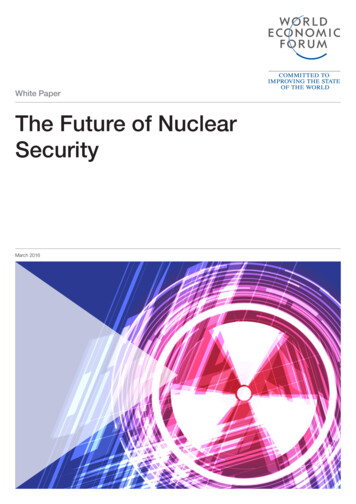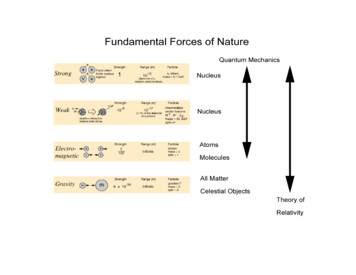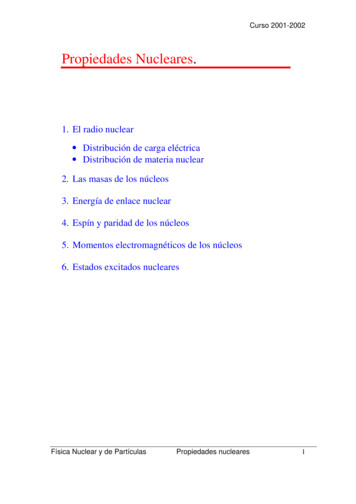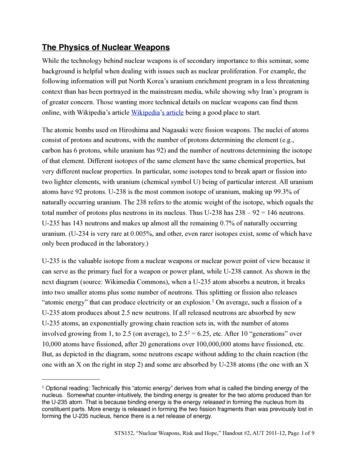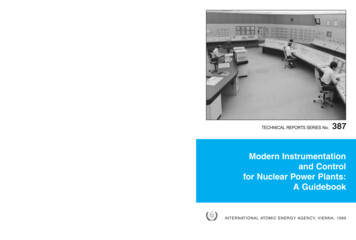
Transcription
Nuclear Information and Resource Service1424 16th St. NW, Suite 404, Washington, DC 20036; 202-328-0002; Fax: 202-462-2183; E-mail: nirsnet@nirs.org; Web: www.nirs.orgJanuary 5, 2000The Secretary of the CommissionU.S. Nuclear Regulatory CommissionWashington, DC 20555-0001Attn: Rulemakings and Adjudication StaffRe: Docket No. 50-219 -- TDear Secretary:In accordance with 10 CFR 2.1306 and 10 CFR 2.174, the Nuclear Information andResource Service (NIRS) submits the following Petition for Leave to Intervene and for aHearing in the matter of the proposed license transfer from Jersey Central Power & Lightand GPU Nuclear to AmerGen Energy Company (LLC) (Federal Register, December 16,1999, pages 70292-70293).NIRS reserves the right to call upon additional experts and attorneys to pursue thismatter. We note that the (presumably deliberate) timing of the license transfer requestallowed only 20 days for members of the public to review the request, research andprepare contentions, find experts and meet other procedural hurdles, and that these 20days included the Christmas holiday and the once-in-a-lifetime Year 2000 holiday andcelebration.Nonetheless, despite the timing of this Federal Register notice-which is clearly intendedto expedite a nuclear reactor license transfer and not to inform the public or encouragepublic involvement in the issue-NIRS has met the procedural hurdles of 10 CFR 2.1306and 10 CFR 2.174.While the Affidavits attached demonstrate ample expertise to pursue the contentionspresented, NIRS on a routine basis consults with numerous "experts" and attorneys.Therefore, we may, as this Proceeding continues, provide Affidavits and testimony fromadditional experts and avail ourselves of additional legal counsel.riten eleae44,.LSUUtLVa( sounorU&4fSUeWFF4arL unf y/L'y.
Respectfully submitted,114/Michael MariotteExecutive DirectorEncl: Petition for Leave to Intervene and for a HearingCertificate of ServiceExpert Affidavits
UNITED STATES Of AMERICANUCLEAR REGULATORY COMMISSIONIn the matter ofJersey Central Power & Light Co. &GPU Nuclear License Transfer ofOyster Creek Nuclear Generating StationTo AmerGen Energy Company (LLC))))))Docket No. 50-219PETITION FOR LEAVE TO INTERVENE IN THE LICENSE TRANSFER OFOYSTER CREEK NUCLEAR GENERATING STATION FROM JERSEYCENTRAL POWER & LIGHT CO. AND GPU NUCLEAR TO AMERGENENERGY COMPANY (LLC)The Nuclear Information and Resource Service (NIRS) and its members WilliamDeCamp, Jr. and Shirley Schmidt (affidavits arriving under separate cover) herebypetition for Leave to Intervene and request a hearing by an Atomic Safety and LicensingBoard in the above-mentioned matter (Federal Register, December 16, 1999, 7029270293) under 10 CFR 2.1306. The following contentions are submitted and meet therequirements of 10 CFR 2.1308 and 10 CFR 2.714.Contention I.AmerGen is financially unqualified to own and operate Oyster Creek.AmerGen Energy Company, LLC (AmerGen) is a consortium composed of two largecorporations, PECO Energy of the United States and British Energy of the UnitedKingdom. As its name indicates, however, AmerGen itself is a Limited LiabilityCorporation (LLC). The primary purpose of forming an LLC is to shield the parentcorporations from undue liabilities-in this case those liabilities that may result fromI
unanticipated operating and capital costs, decommissioning costs, nuclear accidents, andother foreseeable eventualities. Thus when examining the financial qualification of such alicense applicant, it is essential to focus only on the actual applicant corporation, and notthe financial capabilities of the parent corporations.AmerGen itself is a tiny corporation, with few corporate resources. Indeed, its onlyapparent resources are contained in letters dated July 22, 1999 from PECO Energy andBritish Energy, in which each of these corporations agree to commit a maximum of 55million each, or a total of 110 million, to AmerGen to cover "ongoing operatingexpenses at any AmerGen operating nuclear power plant or. to safely maintain any suchplant."A 110 million bankroll may be sufficient to address unanticipated or even major capitalexpenses at a single nuclear reactor site. However, it is insufficient to address suchexpenses at multiple reactor sites, as AmerGen intends.Page 16 (line 6) of AmerGen's License Transfer Application (November 5, 1999) statesplainly, "The Projected Income Statements [for AmerGen] indicate that the source offunds to cover these operating costs [operating, maintenance and capital costs throughDecember 31, 2005] will be operating expenses."2
The next paragraph notes that Jersey Central Power and Light has agreed to purchase"100% of Oyster Creek's capacity and energy" from the closing date until March 31,2003" [not December 31, 2005].While a guaranteed electricity purchase contract would appear to provide sufficientoperating funds for any power plant, the fact is that if the plant does not provide power,there is nopower to purchase and the contract provides no funding. And the history ofOyster Creek suggests that it is reasonably foreseeable that the plant will not providesufficient power over its remaining lifetime to provide AmerGen adequate revenues tosafely operate and maintain the plant.Moreover, the reserve fund-the 110 million guaranteed by PECO Energy and BritishEnergy-is not earmarked for Oyster Creek. In fact, it is to be sha-!d among OysterCreek, and AmerGen's two other recent acquisitions, Three Mile Island-I and Clinton,and presumably with Vermont Yankee as well, which AmerGen is in the process ofpurchasing, and Nine Mile Point-I and -2, which AmerGen is seeking to purchase.Clearly if two or three of these reactors (and perhaps others AmerGen intends topurchase) were off-line for an extend period of time, this 110 million would not besufficient to assure safe operation, maintenance, or even a shutdown condition of thesereactors.Note also that AmerGen (and perhaps a new Canadian subsidiary CanaGen) arereportedly preparing to spend 1 Billion to purchase Canada's Bruce reactors (see
December 20, 1999, The Independent, London, ATTACHMENT A). While this indicatesthat Amergen's corporate partners have substantial funds available, it also indicates thatthe companies may be spreading themselves thin. And in any event, regardless of thefunds available to the corporate partners, the partners have agreed to provide only 110million for operating costs related to Amergen's U.S. reactors (July 22, 1999 letters fromPeco Energy and British Energy to Amergen, ATTACHMENT B & C).Moreover, AmerGen is not considered by the NRC to be an "electric utility," whichmight remove financial qualifications requirements (see NRC decision on TMI- 1 licensetransfer application to AmerGen, 64 FR 19202, April 19, 1999). Indeed, AmerGen isexactly the type of company for which financial qualifications requirements under 10CFR 50.40(b) were contemplated-a relatively new company, with few assets, and alimited liability imposed by its parent corporations.Further, if there were to be a major accident at a non-AmerGen facility, particularlybefore AmerGen were able to accrue substantial operating revenues, or if Oyster Creek orother AmerGen reactors were in lengthy shutdown, AmerGen would be unable to meet itsobligations under the Price-Anderson Act. As enacted by the U.S. Congress in 1987, thePrice-Anderson Act requires, in the event of a major nuclear accident, each reactor ownerto provide up to 10/million per year to a maximum of 63 million per reactor. Thiswould require, in AmerGen's case, a reserve of 189 million ( 378 million if theVermont Yankee and Nine Mile Point purchases go through). Further, it can bereasonably anticipated that were an accident sufficiently large to invoke Price-Anderson4
to occur, many reactors, and certain types of reactors could be expected to close for sometime for repairs and modifications, and new regulatory requirements may be initiated thatwould require additional sources of capital (for example, the TMI Action Plan institutedby the NRC following the less dire Three Mile Island accident).Finally, the NRC staff has not adequately examined, nor published any results of anyexamination, of the implications of an LLC with essentially no assets purchasing not justone, but several nuclear reactors. And, in this case, the LLC is using the same 110million as collateral for purchase of all its reactors.Contention I. A. As a Limited Liability Corporation, AmerGen is inherently financiallyunqualified to own and operate Oyster Creek. An LLC is, by its very nature, designed tosl.ield parent corporations from liability and accountability when things go wrong. Butthe very nature of nuclear regulation and the licensing process is to assure accountabilityand liability from licensees. AmerGen, with virtually no resources of its own, cannotprovide the accountability and ability to meet liability that the nuclear regulation andlicensing process demands. A similar Limited Liability Corporation with limitedresources, Louisiana Energy Services (LES), was found by an Atomic Safety andLicensing Board (ASLB) [44 NRC 331 (December 3, 1996), Docket No. 70-3070-ML,ASLBP No. 91-641-02 ML; ".the Licensing Board resolves in favor of theIntervenor. contention Q concerning the Applicant's financial qualifications to constructthe proposed facility;" see also pages 375-404] to be financially unqualified to build andoperate its proposed uranium enrichment plant near Homer, Louisiana.5
In this case, the ASLB ruled that Louisiana Energy Services (LES) wasfinancially unqualified to construct a uranium enrichment plant and thus found itunnecessary to rule on whether it was financially qualified to operate a uraniumenrichment plant. However, the case is relevant because a) the Limited LiabilityCorporation financial structure of LES is similar to that of AmerGen and thus thefinancial issues are similar; b) the financial qualifications to operate a nuclear powerreactor must surely be greater than those to merely construct a uranium enrichment plant.In that case, the ASLB found that the parent corporations of LES had notguaranteed a sufficient amount of funds to allow construction of the plant and that LES'plans to raise additional construction funds were inadequate. Similarly, AmerGen'scorporate parents have not provided sufficient funds to safely operate Oyster Creek (aswell as AmerGen's other reactors), particularly under situations in which revenue is notbeing generated (i.e., if the plant is shutdown for safety or other reasons, or if OysterCreek is unable to generate power at a competitive rate).The environmental damage caused by a halt in the construction of a uraniumenrichment plant because of financial reasons is limited to whatever site damage (i.e.clearing of forest, etc.) has been caused by the construction. But a nuclear power reactormust be properly maintained, which requires substantial resources, even when it isshutdown and not generating electricity; otherwise it can meltdown and cause acatastrophic accident. Thus, the adequacy of the operating reserve funds is critical andAmerGen's corporate partners have not seen fit to provide adequate funds for OysterCreek and AmerGen's other reactors. Thus, AmerGen is financially unqualified tooperate Oyster Creek under 10 CFR 50.40(b) and 44 NRC 331 (1996).6
Contention I. B. By seeking to rely solely upon "operating revenues" by its ownadmission to meet its costs, AmerGen is financially unqualified to own and operateOyster Creek. If this standard were to be upheld, virtually any individual or corporateentity who could convince a utility to unload a nuclear plant and provide a guaranteedpower contract would be financially qualified to own and operate an atomic reactor. Thisis absurd on its face. Protection of the public health and safety requires substantialfinancial reserves and capability. This is why ownership and operation of atomic reactorspreviously had been reserved for electric utilities (and even some of those have gonebankrupt or otherwise been under severe financial pressure from building and operatingnuclear plants). We note that AmerGen is not considered by the NRC to be an electricutility (NRC decision on TMI-1 license transfer application to AmerGen, 64 FR 19202,April 19, 1999).Further, AmerGen has not adequately provided, as required under 10 CFR50.33(f)(2) ".estimates for total annual operating costs for each of the first five years ofoperation of the facility. The applicant shall also indicate the source(s) of funds to coverthese costs." As noted above and as stated in AmerGen's License Transfer Application(page 16), Jersey Central Power & Light has agreed to purchase whatever power OysterCreek generates from the Closing Date--which is variable and dependent on obtaining alicense transfer and favorable tax treatment from the Internal Revenue Service orCongress ("Certain IRS rulings and/or opinions of tax counsel will also be required inconnection with this transaction, including the rulings and/or opinions necessary to effecta tax efficient transfer of Decommissioning Trust Funds to AmerGen." Page 32,7
AmerGen License Transfer Application, November 5, 1999. AmerGen has sought, so farunsuccessfully, similar tax relief from the U.S. Congress. To date, the IRS has failed tomake a generic tax ruling requested by AmerGen, although it allowed a limited suchruling for the TMI- 1 license transfer.) through March 31, 2003-a period likely to be lessthan three years. For the period following, AmerGen can only provide a vague assurancethat it will sell power at a "market rate," which may or may not be ample to coveroperating, maintenance and capital repair costs.Thus, AmerGen has not met the requirements of 10 CFR 50.33(f)(2) andAmerGen is not financially qualified to operate Oyster Creek under 10 CFR 50.40(b) and44 NRC 331 (1996).Contention I. C. The 110 million guarantee from PECO Energy and British Energy toAmerGen to address shortfalls from operating revenues is insufficient in the case ofOyster Creek, which can reasonably be expected to face, in the near future, manymillions of dollars in costs to replace its Thermo-Lag fire barrier material (declared"inoperable" by the NRC in 1992), address serious spent fuel storage issues, install anew, non-single failure proof crane for heavy load movement or face extendedshutdowns, and cope with many other operating and maintenance costs. Upcoming plantmodifications and other safety-related issues-all of which will require substantial fundsto address-are detailed in the NRC Plant Issue Matrix for Oyster Creek and inContention VI of this filing. Thus, AmerGen is financially unqualified to operate OysterCreek under 10 CFR 50.40(b) and 44 NRC 331 (1996).8
Contention I. D. The 110 million guarantee from PECO Energy and British Energy toAmerGen to address shortfalls from operating revenues is insufficient since there is noreason to believe Oyster Creek will operate reliably or will produce any meaningfulamount of electricity between Closing Date and March 31, 2003, when AmerGen'scontract with Jersey Central Power & Light expires. Indeed, Oyster Creek's checkeredhistory suggests that the plant will produce 65% or less of its available capacity, and mayproduce none at all, given the large amount of safety-related work that needs to be doneon the plant (see Contention VI). Thus, AmerGen is financially unqualified to operateOyster Creek under 10 CFR 50.40(b) and 44 NRC 331 (1996).Contention I. E. The 110 million guarantee from PECO Energy and British Energy toAmerGen to address shortfalls from operating revenues is insufficient since AmerGenhas no contract to sell electricity from Oyster Creek beyond March 31, 2003 except avague pledge to sell power "at market-based rates." Oyster Creek's history is one ofproviding higher-cost power than its competitors, not lower-cost or market-based costthis is the primary reason GPUN had planned to close the reactor permanently in 2000.Thus, there is no reason to believe that AmerGen will be able to sell electricity afterMarch 31, 2003, unless it is able to cut operating costs to a level that would threatenpublic health and safety (see also, Contention II). Thus, AmerGen in financiallyunqualified to operate Oyster Creek under 10 CFR 50.40(b) and 44 NRC 331 (1996).Contention I. F. The Nuclear Regulatory Commission has not adequately examinednor can we find any examination at all--of the financial implications of AmerGen9
owning more than one reactor. This is particularly important in this case becauseAmerGen is relying upon the same 110 million commitment from PECO Energy andBritish Energy to meet unforeseen operating and capital expenses, shutdowns, and otherproblems, at all of AmerGen's reactors. Currently that means Three Mile Island-1,Clinton, and Oyster Creek. However, AmerGen publicly has expressed its intent (seeattached articles, Newsreal's Industrywatch, July 25, 1999; Wall Street Journal,October28, 1999, ATTACHMENTS D & E, respectively) to purchase and operate other reactorsas well, and has engaged in an agreement to purchase Vermont Yankee. It also has anagreement (now disputed) to purchase Nine Mile Point-I and -2. In real terms, the 110commitment currently is only about 36 million per reactor, and the per/reactorcommitment would be further reduced if the other purchases are completed. Extendedshutdowns and/or major capital costs related to nuclear safety reasons would deplete thisminimal fund quite quickly. However, the NRC staff appears to be accepting this figureon a per/reactor basis, rather than on the entire AmerGen fleet of reactor basis that itactually is. Note that page 18, line 19 of the AmerGen/GPU-N license transferapplication (November 5, 1999) states that "[T]he Funding Agreements entered into byPECO Energy and British Energy provide reasonable assurance that AmerGen will havefunds sufficient to pay the fixed costs of an outage lasting six months, as suggested in theguidance provided in the standard Review Plan." However, this assurance is on a singlereactor basis, not a multiple reactor basis. Indeed, footnote 8 on the next page of theapplication indicates that the fixed operating costs for Oyster Creek for six months areIf 60 million-and this clearly does not include any major modifications or upgrades.all three of AmerGen's reactors were down for six months (a somewhat unlikely, but10
certainly not far-fetched scenario), the costs would be far above AmerGen's resources tocover. Thus, AmerGen does not meet the financial qualifications required under 10 CFR50.40(b) and 44 NRC 331 (1996).In addition, both AmerGen itself and one of its two corporate parents (BritishEnergy) are companies created less than five years ago. Thus AmerGen and its parentBritish Energy should be considered "newly-formed entities" and subject to the stricterrequirements of 10 CFR 50.33(f)(3) and (4).Contention I. G. AmerGen is financially unqualified to own or operate Oyster Creekbecause it cannot meet the legal obligations of the Price-Anderson Act (P.L. 100-408),particularly if an accident occurs that invoke- the Act early in AmerGen's operation ofOyster Creek (and/or AmerGen's other reactors), or when Oyster Creek (and/orAmerGen's other reactors) are in extended shutdown or undergoing major safety repairsor modifications. The Price-Anderson Act, by 1988 law, requires each entity with anuclear reactor to pay up to 10/million per year, to a maximum of 63 million perreactor, to cover accident-related damages caused by any nuclear reactor (not just thoseowned by the entity). In AmerGen's case, with only the reactors it so far is purchasing,this would require reserves of 189 million. Note that AmerGen's license application(page 30, Section H) is in error when it states that Oyster Creek's total Price-Andersonpremium would be 10 million (see also 10 CFR 142.92, Article VIII), rather this is apotential annual premium. This would not be an undue burden on most electric utilities;in AmerGen's case, with only a 110 million commitment from its corporate sponsors, itwould mean bankruptcy, especially if an accident were to occur soon, before AmerGen1t
had an opportunity to accrue any substantial operating revenues. Thus, AmerGen doesnot currently meet the requirements of 10 CFR 140.21, in that its commitments from itsparent corporations are not sufficient to meet potential Price-Anderson liabilities for all ofits reactors, and it has not purchased bonds or made other financial arrangements to metthese requirements.Moreover, the Price-Anderson Act will be renewed by the U.S. Congress by 2002.Given the history of the Act, it is reasonable to assume that liability levels for nuclearplant owners will increase, not decrease. And if the Act is not renewed, then AmerGencould face unlimited liability for a nuclear accident, an obligation it obviously could notmeet. For the reason of being unable to meet its statutory obligations under PriceAnderson (Public Law 100-408), and 10 CFR 142.92, Article VIII and 10 CFR 140.21, alicense to AmerGen must be denied.Contention I. H. By seeking to rely almost entirely on operating revenues from itsreactors to meet operating costs (and to obtain any profit), AmerGen will almost surelybe placed in a position where it must consider power production above safety. In otherwords, it will have to choose to operate Oyster Creek when mere prudence might dictatea shutdown. Power production above safety has long been considered by the NRC to bethe greatest sin of a nuclear utility. While there are, of course, NRC regulations againstsuch a course, that hasn't stopped some utilities from emphasizing power productionabove safety, despite the NRC's best regulatory efforts. AmerGen's shaky financialstructure ensures a tension that will encourage power production whenever possible.12
CFRThus, AmerGen is financially unqualified to operate Oyster Creek under 1050.40(b) and 44 NRC 331 (1996).Contention I1OysterAmerGen is unfit, on public health and safety grounds, to own and operatepublic healthCreek. In particular, AmerGen's partner British Energy is unfit, onand safety-grounds, to own and operate Oyster Creek.Contention IIIoperate any U.S.AmerGen is unfit, on public health and safety grounds, to own andis unfit, on publicnuclear reactor. In particular, AmerGen's partner British Energyhealth and safety grounds, to own and operate any U.S. reactor.with two separateFor brevity's sake, while we submit these as two separate contentions,subparts, we will combine the discussion of these contentions.power plant. ItAmerGen, as a corporate entity, has never owned or operated a nuclearnuclear safetyhas neither an employee base nor a knowledge base to draw upon ontwo corporateissues. Instead, AmerGen is relying entirely upon the abilities of itsliability by virtue of theirpartners (which are, as noted in Contention I, shielded from allsafely operate the reactorsLimited Liability Corporation structure) to enable AmerGen toit purchases.13
In addition, in each of its purchase agreements, ArnerGen has stated that it will continueto operate the reactors as they have been operated (presumably according to NRCregulations) and will honor union-labor contracts. However, AmerGen also has madeclear that it reserves the right to make changes at the corporate level; i.e. to bring in itsown people, to lay off people, to change job descriptions, etc. Indeed, even beforeformally taking ownership of the Clinton reactor, AmerGen announced it would reducethat power station's workforce by more than 20 percent (about 200 out of about 930employees). (see article from The Pantagraph,Bloomington, IL, September 10, 1999,ATTACHMENT F).In other words, AmerGen intends to cut costs, and the only place to substantially cutcosts in a heavily-regulated industry like nuclear power is by cutting people and salaries.Given the current high costs for electricity produced by AmerGen's Clinton and proposedOyster Creek reactors, cutting costs will be the only way AmerGen can sell power at"market-based" rates once its rather short sweetheart contracts with its reactor sellersexpire.In this regard, it is instructive to look at the experience of AmerGen partner BritishEnergy, an entity which, having been handed much of the U.K. nuclear power industry,undertook a massive cost-cutting and personnel layoff program that, according to theU.K. equivalent of the NRC, is jeopardizing public health and safety and has causednumerous safety-related events at U.K. reactors.14
It is worth pondering for a moment exactly why PECO Energy chose to join with BritishEnergy to create AmerGen. It certainly was not British Energy's expertise in operatingU.S. reactors, British Energy has never operated a reactor in the U.S., and has noexpertiseexperience with the U.S. nuclear regulatory system. Nor was it British Energy'sin operating specific types of nuclear reactors found in the U.S., since British Energyoperates only one Pressurized Water Reactor of U.S. origin (Sizewell B), and none ofNorAmerGen's purchases or proposed purchases so far have been of this reactor design.sincewas it even a need by PECO Energy to find a partner with a large amount of cash,PECO itself has a large amount of cash as a result of utility deregulation and strandedwithcost recovery in Pennsylvania. Clearly, the only reason PECO Energy allied itselfBritish Energy is the one area in which British Energy is far ahead of its U.S.counterparts: downsizing and labor cost-cutting.of the U.K.'sBut it is precisely this downsizing and labor cost-cutting that have run afoulsafety-relatedNuclear Installations Inspectorate (NII), and that have resulted in numerousincidents at British Energy reactors.at the time ofThe ASLB should note that none of this information was publicly availablehaveeither the TMI- 1 or Clinton license transfer applications, nor at the time it wouldof thisbeen, possible to intervene in these license transfer applications. Indeed, someReportinformation remains unavailable to the public; however, NIRS is attaching NIIEnergySafety Management Audit of British Energy Generation Limited and Britishfrom TheGeneration (UK) Limited, 1999 (ATTACHMENT G) and a copy of an article15
Guardian, December 20, 1999 (ATTACHMENT H), which describes documents fromBritish Energy on its actions in response to the NII investigation (Note: NIRS isattempting to obtain a copy of the documents described in the Guardian).According to the initial 1999 NII investigation, British Energy's cost-cutting feverreached such a pitch that by the time of the report, for its 11 operating reactors BritishEnergy did not have a single expert in severe accident analysis on its payroll: nobodywho could analyze engineering changes to determine their effects on nuclear accidents.British Energy had only one fire protection expert on its staff-to address fire protectionissues at all 11 of its reactors. There was also a "shortage or lack of key expertise inirradiation embrittlement . and austenitic steel inspection. "(page 12) among otherstaffing deficiencies.Overtime for plant workers is substantial. Some worked in excess of 60% overtime (page14). Even target levels of overtime were 20%. Nuclear inspectors wrote that theysuspected the actual overtime hours were far higher. Contract employees, with little to noknowledge about the facilities they were overseeing, made key nuclear safety decisions.This 101-page report, and we hope the ASLB will read all of it, is replete with similarsituations and shortcomings by British Energy.In the report cited by the Guardian article of December 20, 1999, the utility detailedmore than a dozen different safety-significant events related to British Energy's poorstaffing, management and maintenance practices. Moreover, the Guardianarticle16
reported on a memo outlining British Energy's disagreements with the NII conclusionsand recommendations-indicating that British Energy's commitment to improveoperations and cooperate with regulators is suspect at best.AmerGen (and the NRC) may argue that NRC regulations may require certain staffinglevels, or may otherwise prohibit such aggressive cost-cuttings. Actually NII regulationsprohibit this as well (see pages 5-6 of NII report: "A set of 35 conditions is attached toeach license."). But mere regulations and the letter of the law didn't stop BritishEnergy, making it uniquely unqualified to possess a license to own or operate a U.S.nuclear reactor. In addressing the issue of foreign ownership of U.S. reactors, AmerGenstates that U.S. personnel will be in charge of Oyster Creek and AmerGen' s otherreactors. That may meet the letter of the law, but it is hardly reassuring, since there is noother conceivable reason for British Energy, itself a relatively new, inexperiencedcompany (formed in 1996) to be part of AmerGen except for its expertise in cost-cutting.Collectively, the actions of British Energy-including substantial violations of U.K.nuclear power regulations--and the increased risk to the public of the U.K. caused bythose actions, as documented by the numerous safety-significant events that haveoccurred in the second half of 1999 alone, mean that there is not "reasonable assurancethat the applicant will comply with the regulations in this chapter, including theregulations in part 20, and that the health and safety of the public will not beendangered." (10 CFR 50.40(a). In addition, the actions of British Energy preclude thenecessary Commission finding under 10 CFR 50.40(c), "The issuance of a license to the17
applicant will not, in the opinion of the Commission, be inimical to the common defenseand security or to the health and safety of the public."Contention 1I. A. British Energy, and by extension AmerGen, is unfit to hold a license toown and operate Oyster Creek. British Energy has flouted the nuclear safety la
admission to meet its costs, AmerGen is financially unqualified to own and operate Oyster Creek. If this standard were to be upheld, virtually any individual or corporate entity who could convince a utility to unload a nuclear plant and provide a guaranteed power contract would be financially qualified to own and operate an atomic reactor. This

